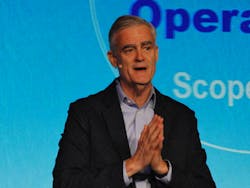Boldly targeting sustainability of, by & with Emerson
Achieving net-zero sustainability by 2050 is a massive, complex, daunting and critical challenge, relying on a roadmap of halving greenhouse-gas emissions every decade, according to the opening keynote presenters at Emerson Exchange, who stressed that we must cut global emissions in half by 2030, then halve them again by 2040 in order to stay on track.
To summarize its own strategy about this global undertaking, Emerson uses three simple words: of, by, with. Sustainability programs are operated “Of Emerson,” “By Emerson,” and “With Emerson”.
“The world has a deadline,” said keynote presenter Mike Train, who previously oversaw Emerson’s automation solutions business before adopting his current title of chief sustainability officer. It’s “the best job in the company,” he beamed.
The greening “of Emerson” references sustainability initiatives that take place within the walls of Emerson itself, relying on the latest climate science to inform what the most critical drivers of change will be. The target is that net-zero state. “It’s a high mark,” Train said, with a tone of optimism in his voice.
Greening “by Emerson” references programs to help customers decarbonize their own operations with the help of Emerson tools and technologies.
Greening “with Emerson” references collaborating on sustainability programs with academic institutions and industry groups, government agencies and energy councils. “Emerson has tremendous global reach,” said Train. “We are able to bring to these dialogues our focus and at-scale examples of solutions.”
That greenhouse-gas-reducing goal is all about business outcomes, said Train, a “cultural shift to how we view sustainability.” Yes, it’s a massive undertaking, he admitted; nothing less than the transformation of the world’s energy system. “And it’s going to happen very quickly,” he warned.
These varied initiatives align with specific scopes that detail the types of emissions being targeted for reduction:
- Scope 1—Direct emissions from owned or controlled sources (e.g. combusted natural gas in industrial sites). Consider these emissions that an enterprise, itself, produces.
- Scope 2—Indirect emissions from the generation of purchased energy…energy that is purchased for use on site, with the emissions taking place elsewhere (think electricity).
- Scope 3—All indirect emissions included in Scope 2 that occur in the value chain, both upstream and downstream. For example, emissions related to the products that Emerson buys, or those created when customers use Emerson goods. “This drives our mission to create energy-efficient products,” said Train. “I take responsibility for those in my Scope 3.”
Complex? For sure. Achievable? Yes.
“The energy road ahead will be far more diverse,” added Mark Bulanda, executive president of Emerson Automation Solutions, who joined Train for part of his presentation. “We will rely on a mix of traditional and new energy sources, each contributing to our collective goals. Digital automation is at the center of that, and it’s happening now.”
That mix includes smart, automated approaches to energy-source decarbonization and emissions management, electrification and system integration, energy optimization and efficiency. It also includes smart partnerships with emerging enterprises like Neste, which develops sustainable aviation fuels, and Origin, which converts wood waste to carbon-negative chemicals.
The greatest opportunity, the pair said, is a shifted mindset. “Energy efficiency is the best opportunity for sustainable use of resources,” Train explained, noting that as much as two thirds of energy is lost due to inefficiencies in industrial processes. Become more efficient and you become more sustainable. Every industry has an opportunity to improve, he stressed. Every enterprise can lower its energy consumption, which then reduces its emissions.
And just as it is critical within Emersion to maintain these sustainable strategies, it is also imperative to collaborate with other sustainability leaders, other operations experts, other automation front-runners to find, implement and maintain smart solutions. “Automation professionals know how these things are run,” said Train. “We have the tools and expertise. We can demonstrate progress.”
Progress into the next decade. Then the following. Then onto 2050.
The keynote presentation ended with this quote from explorer Robert Swan, “The greatest threat to our planet is the belief that someone else will save it.”
Emerson’s response, as detailed here today, reveals a comprehensive, collaborative commitment to responsibility on this front, summarized with three simple words: of, by, with.
Get the best of Emerson Exchange Americas 2022
When the event comes to a close, the best, most important coverage will be compiled into a report. Register now to pre-order the report and be among the first to receive it in your inbox.
About the Author
Chris McNamara
Smart Industry

Leaders relevant to this article:

